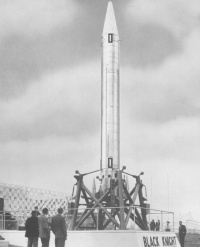Black Knight
From The Space Library
Saunders Roe Black Knight Missile (circa 1958)
The Black Knight missile program began in 1954 as a project of the Royal Aircraft Establishment (RAE) and the Saunders Roe Company of England. Black Knight was intended as a test vehicle for lobbing dummy nuclear warheads into space to monitor their behaviour during re-entry.
On November 5th 1956 De Havilland bought an interest in Saunders Roe and when the first Black Knight was fired from Woomera Australia on September 7th 1958, the launch team was supervised by H.G.R. Robinson of RAE and K.M. Burtt of De Havilland Propellers Ltd, who was the team leader.
De Havilland had been working with rocket engines since the late 1940s in conjunction with the newly formed Rocket Propulsion Establishment. The RPE had recruited a team of Germans after the war led by Johannes Schmidt. Schmidt had worked on the Walter 109-500 used on the ME-163 interceptor. Two of these Walter engines, which used high test peroxide (HTP) as an oxidizer, were brought to England and fitted to an Avro Lancastrian (one of the aircraft which James C. Floyd had worked on) to see if they would be useful as JATOs. The success of that experiment led to De Havilland going ahead in 1951 with their own HTP engine project. The first engine was the Sprite ATO followed by the Super-Sprite unit for the Vickers-Valiant aircraft. Both built while Arthur Valentine Cleaver of the British Interplanetary Society was chief rocket engineer at the De Havilland Engine Company.
This led to the Spectre JATO rocket, which was first tested in December 1956. After the early tests aboard an English Electric Canberra the engine was fitted to a Saunders Roe S-R 53 interceptor research aircraft. The first flight of this configuration was in May 1957.
Ultimately the work done at Saunders Roe, RAE and De Havilland on rockets using HTP led to the extremely reliable engines used on the Black Knight.
Black Knight would be launched successfully 22 times using HTP and kerosene. It used four thrust chambers each generating about 4,000 lbs. Total thrust rose to about 18,000 lbs outside the atmosphere. The Black Knight was normally about 35 ft tall and 3 ft in diameter.
In about 1960 the De Havilland engineer Geoffrey Pardoe proposed a modified version of Black Knight as a second stage for the De Havilland Blue Streak LRBM. This combination would have allowed Britain to enter the space race with its own satellite launcher. Although this configuration never flew, the engines from Black Knight would evolve to power the Black Arrow launcher which put England's satellite Prospero into orbit in 1971.

